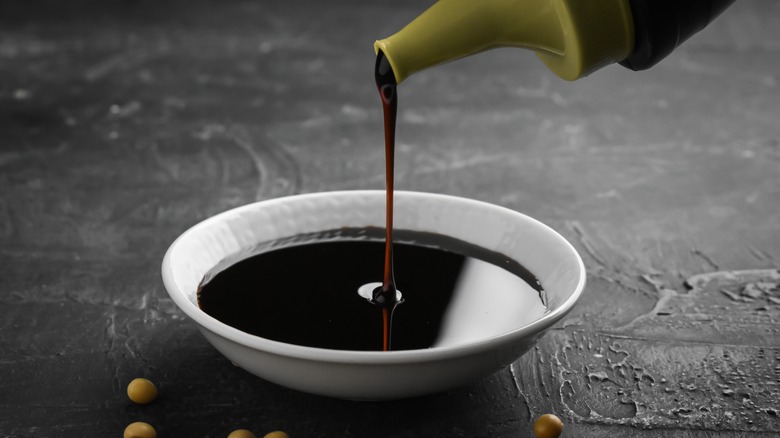When To Use Soy Sauce As Your 'Secret Ingredient'
With its salty yet sweet flavor, soy sauce can turn simple things such as pasta, rice, or chicken wing recipes into a gourmet experience. This versatile ingredient has been around for more than 2,000 years, and its popularity continues to increase. Today, it's available in different versions, from koikuchi-shoyu, or dark soy sauce, to double-fermented soy sauce, according to WebMD. Most recipes call for soybeans, salt, wheat, and mold or fungi, such as Aspergillus oryzae. The latter plays an important role in fermentation.
What makes soy sauce stand out from other condiments is the umami taste, explains a 2010 review published in the Journal of Food Science. This distinct flavor results from the fermentation of soybeans, but it could also be due to the interaction between free amino acids, peptides, and other molecular compounds. Umami, or the fifth taste, makes food more palatable and balances the flavors.
Soy sauce may also benefit your health, despite its high sodium content. As WebMD notes, this condiment is rich in antioxidants and may help prevent free radical damage. Plus, the isoflavones in soy can improve blood lipids and ease menopause symptoms, among other benefits. Soy sauce may soon become your secret ingredient — you just need to know when and how to use it for maximum impact.
What's the best way to use soy sauce?
Contrary to popular belief, soy sauce isn't just for sushi and other Asian dishes. You can use it in dozens of recipes, from soups and stews to meat dishes. For example, food blogger Alex Cook usually adds soy sauce to roasted pepitas, noodles, gravies, and homemade snacks. "It's a key ingredient in my Mushroom San Choy Bow, a great vegan option that develops a hearty, meaty depth of flavor thanks to the use of this seasoning," he told American Express Essentials.
Bon Appétit describes soy sauce as "umami and salt in liquid form." Its distinct flavor can complement marinated chicken, steak, or even salad dressings. Ideally, you should add it to your meals before seasoning them with salt. Use it in small amounts to prevent it from overpowering the other ingredients.
Soy sauce also goes well with turkey drumsticks, green beans, teriyaki chicken, fried rice, and steamed fish, notes Taste of Home. What's more, it can be a wonderful addition to chicken ramen salad, tofu salad, grilled salmon, and stir-fry recipes. For example, grilled veggies aren't that great by themselves, but they'll taste amazing if you add just a few drops of soy sauce.
Not all soy sauce is created equal
Soy sauce comes in different varieties, and each has distinct characteristics. Light soy sauce, for instance, can substitute for salt and enhance food flavor. Dark soy sauce, on the other hand, will add color to your meals and boost their visual appeal. "Use a little light soy for flavoring and dark soy for color and caramelization," Australian chef Dan Hon told The Guardian. He also recommends adding soy sauce to spaghetti Bolognese and other pasta dishes.
Generally, light soy sauce has a milder flavor than the dark version, explains WebMD. By comparison, tamari soy sauce is darker in color and has a mild taste, too. White soy sauce is higher in wheat, which gives it a light yellow color, whereas dark soy sauce boasts a thicker texture and a sweeter flavor than other varieties.
According to Cook's Illustrated, white soy sauce works best as a condiment for steak or other dishes where soy is not meant to be the dominant flavor. For example, fried rice isn't particularly flavorful, so you may add dark soy sauce to enhance its aroma. White soy sauce, on the other hand, is too mild to change the taste of food. Tamari soy sauce is somewhere in the middle and goes well with most dishes, from salads to eggs, fish, and rice.


